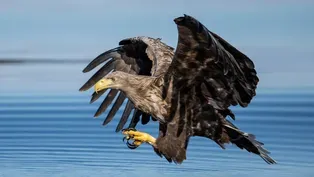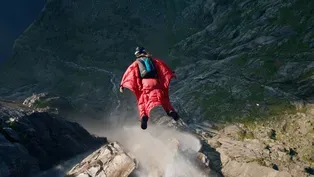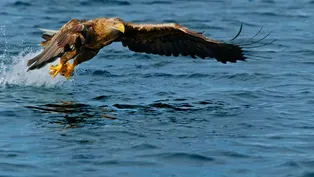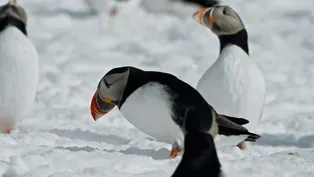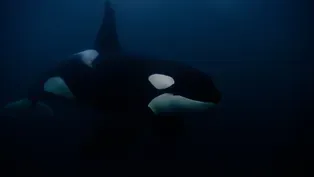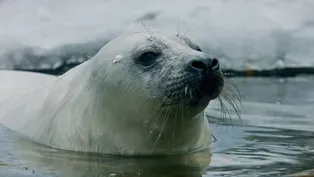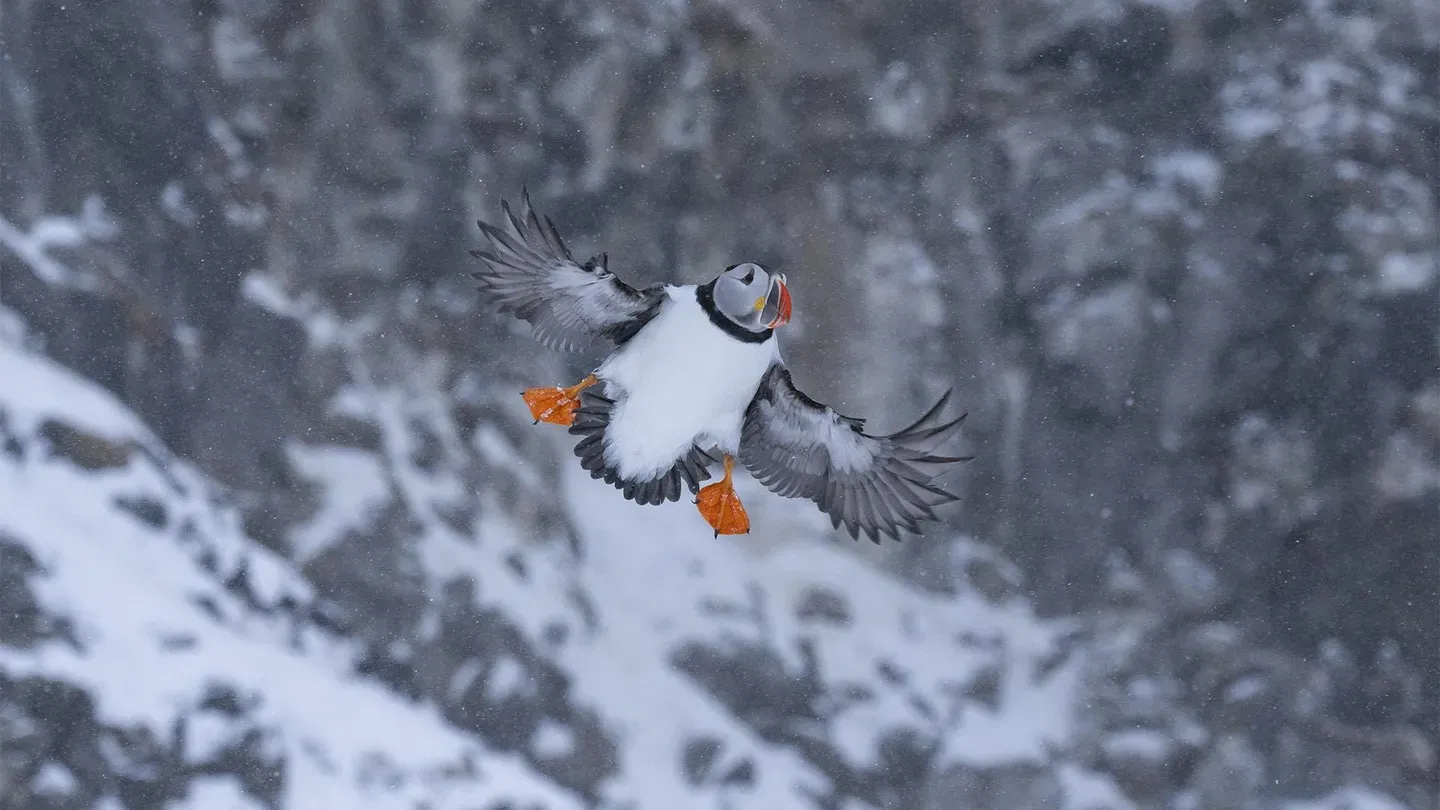

Life on the Edge
Episode 1 | 54m 30sVideo has Closed Captions
The Scandinavian coast is a place of haunting beauty and dangerous extremes.
Scandinavia’s wild and unpredictable coast is a place of haunting beauty and dangerous extremes. Home to sea eagles, otters, base jumpers and orca. Only the tough and resourceful can carve out a Life on the Edge.
Problems with Closed Captions? Closed Captioning Feedback
Problems with Closed Captions? Closed Captioning Feedback

Life on the Edge
Episode 1 | 54m 30sVideo has Closed Captions
Scandinavia’s wild and unpredictable coast is a place of haunting beauty and dangerous extremes. Home to sea eagles, otters, base jumpers and orca. Only the tough and resourceful can carve out a Life on the Edge.
Problems with Closed Captions? Closed Captioning Feedback
How to Watch Wild Scandinavia
Wild Scandinavia is available to stream on pbs.org and the free PBS App, available on iPhone, Apple TV, Android TV, Android smartphones, Amazon Fire TV, Amazon Fire Tablet, Roku, Samsung Smart TV, and Vizio.
Buy Now
Providing Support for PBS.org
Learn Moreabout PBS online sponsorshipNarrator: Scandinavia's coastline is a story over 90,000 miles long.
[Waves crashing] From its warmer southern shores north to chilling Arctic seas, a place of haunting beauty and dangerous extremes... [Waves crashing] ♪ but also rich with opportunity.
Embracing these moments is the secret to survival on this wild, unpredictable frontier.
[Splashing] ♪ [Birds calling] ♪ Scandinavia is a land steeped in myth... the realm of Thor and Odin.
♪ From Norway's frozen wilderness... [Grunts] deep into magical Swedish forests... ♪ across Denmark's windswept shores... [Grunts] to explosive Icelandic volcanoes.
[Explosions] ♪ these breathtaking landscapes... ♪ [Skates scraping ice] have shaped its people... ♪ and its wildlife... ♪ bound together by a resilient spirit.
They each face unique challenges in wild Scandinavia.
♪ As Scandinavia emerged from the last ice age, a spectacular coastline was revealed, reaching out into the turbulent Arctic and Atlantic Oceans... but our journey begins in the more sheltered Baltic Sea.
[Waves lapping] Off the coast of Sweden, 30,000 islands stretch far out into these icy waters.
And at the outer fringes, this skerry has some new arrivals... [Grunting and squealing] ♪ over 1,000 gray seal pups.
♪ They may look laid back, but they're all in a perilous race against time.
[Snorts] Just 18 days after being born, they will be abandoned by their mothers.
Before that moment, to have the best chance of survival, the pups need to quadruple their body weight.
[Grunting] Glugging almost a gallon of super-rich milk a day builds up blubber, a vital energy store, and protective insulation.
[Gulping] [Thunder] On this exposed coast, fortunes can change in an instant.
[Wind howling] All the more reason for this pup to grab a quick drink.
In addition to the demands of her pup, this mom is having to deal with an amorous male looking for a mate.
[Grunting] ♪ She's not in the mood... [Growling] and lets him know.
[Continues growling loudly] It's her pup that needs all her attention... especially now as the swell builds ahead of a late Spring storm.
♪ Pups that linger too close to the edge are vulnerable to rogue waves.
[Calling] ♪ [Waves crashing] [Birds calling] Pups washed into the sea quickly succumb to the cold.
In the Baltic, up to half of all pups don't make it through their first year.
The squall has left the shoreline treacherously icy.
[Birds calling] But with so few days together, crucial life lessons can't be put off.
[Crying] This pup needs to improve his swimming skills... [Grunting] and mom needs to be on her guard.
Aggressive bull seals skulk around the shoreline.
♪ ♪ The water is dangerously cold for the pup, as his fur offers little insulation.
So, this must be a quick dip.
♪ She stays close... [Grunting] but then a sneaky male intrudes.
♪ Instinct drives the pup towards shore... ♪ but the way is blocked by another male.
[Crying] [Grunting] Forced back into the surf, the pup is swept away.
♪ [Waves crashing] [Grunting] Amongst the slush a sign of life.
[Splashing] ♪ Washed into a cove, this pup has been lucky... [Cries] [Cries] but his ordeal is far from over.
♪ Spurred on by his mother's calls, he slowly crawls his way over the ice to safety.
[Cries] [Cries] ♪ [Cries] [Cries] ♪ Reunited, it's time for a warming feed.
These devoted mothers have not eaten since giving birth... sacrificing 1/3 of their body weight to give their pups the best start in life.
[Birds calling] Now starving, they must abandon their pups and return to the sea to feed.
[Crying] One last look, and she's gone.
[Crying] ♪ Too young to follow, the deserted pups head inland.
Here they stay for several weeks, living entirely off their blubber reserves.
[Growling softly] They shed their white fur and grow a shorter waterproof coat, an outward sign of miraculous changes happening to their bodies as they transform into seagoing youngsters.
[Grunting softly] ♪ Finally, they're ready to take the plunge and leave these ancient granite islands behind.
Further south, rocky shores give way to ever-shifting sands.
[Strong winds blowing] This stretch of Denmark's coast is part of the largest tidal flats on the planet.
Over 500 square miles of silt and mud reshaped and revealed with the ebb and flow of each tide.
[Water splashing] it's a vital refueling stop for millions of birds on their annual migration to the Arctic to breed.
[Birds calling] Mingling with the locals, these travelers are drawn here by a smorgasbord of delicacies buried in the mud.
And these worms, clams, and crustaceans are best gathered as the flats are exposed by the falling tide.
♪ Each bird has its own unique way to harvest the hidden feast.
Avocets sweep the silt, snagging worms and shrimps.
♪ With their long, straight bills, godwits probe the deeper mud... ♪ whilst red knot patrol the tidelines hunting for clams to swallow whole.
[Red knot calling] The feasting continues until the tide turns.
Then, as the water rises... food is once again submerged beyond the reach of the longest beaks.
♪ Buffet over, they take to the air in their thousands... ♪ finding safety in these shape-shifting crowds.
♪ For a few weeks, they are bound to the rhythm of the tides... ♪ before resuming their journeys.
Heading north, many will pass over Skagen Point at the very tip of Denmark.
Here, water funneling out of the Baltic meets the tidal surges of the North Sea.
Together, they give rise to a new force, the Norwegian Current, which powers its way toward Scandinavia's most spectacular coast... ♪ the Norwegian fjords.
♪ Long-twisting canyons formed when glacier-carved valleys flooded with seawater at the end of the last ice age... ♪ while, according to legend, these rocks are the bones of Ymir, a giant slain by the Norse god Odin.
♪ Some fjords reach over 100 miles inland with sheer walls rising 3,000 feet.
♪ This rugged coastline nurtured the Viking traditions of seafaring and exploration.
♪ Someone continuing that same spirit of adventure is Hege Ringard.
Ringard: I mentally prepared the whole hike.
It's one thing I definitely like, being on mountains is that they're massive, and I'm this little lady, like, walking around there, and you're vulnerable.
Narrator: Many Norwegians embrace the idea of friluftsliv, a passion for the outdoors, but Hege takes this tradition to the extreme.
[Zipping] Ringard: Walking to the edge, I focus on my breathing.
I am very much in the moment.
Narrator: She needs to be totally in tune with the elements.
Her life depends on correctly reading the wind and the weather.
Ringard: You can never really trust the weather forecast, but you can trust what you see right in front of you.
What you can see right away is the waterfalls.
How are they falling-- straight down, or are they moving a lot?
And that could be a good hint that maybe it's good day to go base jumping.
[Wind whooshing] I clap.
My body and my brain is, like, working together, and the clap is like a little wake-up thing... And then, I jump.
[Jump suit flapping] ♪ [Wind whooshing] ♪ Slowly, the--the wings will fill up with air.
It's like this soft, sweet motion.
It doesn't feel that fast, actually.
♪ It's like, uh...enjoy the view kind of thing and get off the mountain.
♪ Narrator: Norway has more fjords than anywhere else on the planet.
Their twists and turns add over 16,000 miles to Scandinavia's coastline.
So, Hege has endless possibilities to satisfy her obsession.
♪ [Water splashing] Ringard: It's such a cool way to... go up on the mountain and then fly off of it.
[Clapping] It feels like a privilege... ♪ thinking about just being there in the moment.
I'm not thinking about what's for dinner later.
I'm just enjoying it.
♪ ♪ [Parachute rustling] ♪ Being out there just makes me feel good... so that's why I keep going back again and again.
♪ Narrator: These monumental landscapes are only part of the fjords' story.
They are as deep beneath the water as they are high above it.
Stretching down beyond 3,000 feet is a secret underwater world where creatures from the deep ocean can be found close to shore.
Ghost sharks haunt the depths, hunting for shellfish.
They have huge eyes to make the most of the thin light filtering down from above... and receptors in their jaws to sense the tiny electric currents produced by prey.
[Crackling] ♪ Tough shells are crushed by a set of hard plates that line their mouths.
The scavenging crab may be a little too big to tackle... even when a second shock hones in on the action.
♪ [Bird calling] Where the fjords spill out towards the open sea... tides churn the shallow water into a plankton-rich soup... a hunting ground of some voracious predators.
Lion's mane jellyfish.
With a dome up to 3 feet across, these giants trail hundreds of delicate tentacles to trap plankton and fish.
Up to 100 feet long, each tentacle is packed with stinging cells that fire when touched, paralyzing their victims.
♪ But some have turned these deadly trip wires into a safety net.
♪ Whiting fry seem immune to the jellyfish stings, which gives these hitchhikers a refuge from other predators.
♪ When conditions are right, jellyfish numbers can explode.
♪ And other ocean drifters, comb jellies, can also multiply into great seasonal swarms.
Riding the current, they are carried north along the Norwegian coast.
[Waves crashing] For the next 500 miles, the mainland is protected from the turbulent Atlantic by thousands of small islands.
Behind this natural storm barrier, there are calmer waters... stronghold of one of Scandinavia's most iconic creatures... [Bird calling] ♪ the white-tailed sea eagle, riding the coastal breeze on massive 8-foot wings.
Odin was said to transform into an eagle to survey his realm... and these sharp-eyed opportunists don't miss a trick.
[Screeching] Swooping down at 40 miles per hour, they must time their grab to perfection.
♪ Curved talons and spiny scales on their toes help grip slippery fish.
♪ Catching a fish is one thing.
Keeping hold of it quite another.
♪ Distinguished by its muffled tail, this young sea eagle is pushing his luck... [Screeching] but has little chance against the flying skills of an adult.
[Screeching] Whilst youngsters are perfecting their fishing technique, piracy is a shortcut to a full stomach... [Screeching] especially when the victim is another juvenile, more easily intimidated into dropping its catch.
♪ ♪ A fish can be won and lost many times in the chaos of a chase.
♪ [Screeching] ♪ ♪ [Screeching] And things don't always go to plan.
♪ [Splash] It takes years for these novices to become as skilled as the resident adult.
[Bird calling] In the last century, these majestic eagles were almost hunted to extinction.
Now protected across Norway, the population has grown to over 6,000 mature birds, which means there's little chance of a quiet meal, as gangs of hungry youngsters gate-crash the party.
♪ [Squawking] ♪ These boisterous juveniles will spend several years wandering the coast before finding a place of their own.
[Squawking] Whilst sea eagles seldom leave this maze of inlets and islands, the search for fish takes others far out into the North Atlantic.
[Birds calling] Captain Kjartan Gudmundsson commands the "Drangavik" and her 10-man crew as they trawl for cod off the coast of Iceland.
After being heavily overfished, careful management and strict quotas means this fishery is now considered sustainable.
[Engine chugging] Fishing is in the captain's blood.
[Speaking native language] [Waves crashing] Narrator: The open ocean is unforgiving... but the crew must set and retrieve the net whatever the weather.
[Waves crashing] Narrator: Even with the latest technology, it takes all his experience to put the "Drangavik" in the right place at the right time.
Just 3 successful trawls can fill the ship's hold and allows Kjartan to set course for home.
The richness of these offshore waters owes much to a powerful current that sweeps across the Atlantic from the tropics.
Every second, the Gulf Stream delivers 9 million tons of warm water into these Northern seas... enough heat to keep sea temperatures along the Norwegian coast much warmer than other places on the same latitude.
The Lofoten Islands are over 100 miles inside the Arctic Circle.
yet here, the sea never freezes.
[Bell tolling] Settlements cling to the narrow shores... huddled around inlets that offer safe haven all year round.
Most coastlines this far north will be locked in ice for 6 months... but warmed by the Gulf Stream, winter sea temperatures here are kept a few degrees above freezing... just enough to support some surprisingly busy sea life.
Sea cucumbers emerge to feed in the current.
They trap plankton and algae in their feathery tentacles... each taking turns to push food into its central mouth.
Starfish gather together in large numbers.
On cue, they raise themselves up on tiptoes.
Standing tall in the current, they synchronously shed millions of eggs and clouds of sperm.
These mix in the swirling water before the fertilized eggs and larvae are carried away with the flow.
♪ [Wind whooshing] Through the winter, the Gulf Stream keeps the sea from freezing... but its heat doesn't reach far into some Northern fjords.
Where rivers drain into these inlets, the cold fresh water can freeze, forming a shelf of ice.
[Splashing] A welcome hunting platform for an otter... and it's landed a prize catch.
But out on the ice, this otter is exposed.
[Screech] A young sea eagle up to its old tricks.
The only safe place is back in the water until the coast is clear.
These Norwegian otters live further north than any others on the planet.
Benefiting from the relatively mild climate and the wealth of sea life nurtured by the Gulf Stream, these otters survive hundreds of miles inside the Arctic Circle.
This very special combination has also enriched the Lofoten Islanders for centuries.
[Birds screeching] In late winter, vast shoals of migrating cod arrive in these sheltered waters to spawn... [Boat horn blows] and the local fishermen exploit the unique Lofoton climate to preserve their catch.
♪ During the annual Lofotfiske season, fish are hung out to dry on huge wooden racks.
♪ These fillets and fish heads don't need smoke or salt to preserve them because the Gulf Stream keeps the air temperature just stable enough to stop them from rotting as they dry in the Sun and wind.
♪ It's a 1,000-year-old tradition dating back to the Vikings, who traded these dried fish all over Southern Europe.
[Racks creaking] By the end of the season, these racks will be groaning under the weight of thousands of tons of fish.
The riches of this coast destined to be shipped all around the world.
♪ Journeying to the very north of mainland Scandinavia, the coast becomes wilder and even more unpredictable.
[Waves crashing] The Gulf Stream meets its match, as it comes up against the chilling Arctic Ocean.
This powerful collision can generate violent storms, massive surges that churn up nutrients from the deep.
[Birds calling] After spending the winter far out to sea, tens of thousands of seabirds converge on the island of Homoya.
It's the bounty of these waters that support such ravenous gatherings.
Huge ruffs ride the swell.
Guillemots dive down 100 feet and stay underwater for up to 2 minutes as they search for small fish and crustaceans.
They are as much at home underwater as they are in the air... until it's time to make landfall, to nest, and raise their chicks.
This is one of Scandinavia's most magnificent wildlife spectacles.
[Squawking] ♪ Whilst 30,000 Guillemots pour in to claim a spot on the narrow ledges, puffins head for the windswept lower slopes.
Returning birds seek out the nest burrows they've used in previous years, even if they are still buried under the snow.
And these are where mates will meet up again after their long winter at sea.
Rubbing beaks reinforces their lifelong bonds.
As the weather clears, more birds join the throng... including a puffin rather late on the scene.
While all over the colony birds are settling in, he faces an uphill struggle.
With 8,000 puffins nesting on Homoya, the slopes are already crowded.
He must navigate through this increasingly fractious crowd to his old nest hole.
With burrows always in short supply, everyone is ready to defend their patch.
♪ He keeps his head down, hoping to avoid any trouble... ♪ but he's unwittingly strayed into dangerous territory.
[Squawking] A gaping beak is a warning and the wider the beak, the angrier the puffin.
♪ [Grunting] And puffins fight dirty.
♪ ♪ His burrow is up there, but without reclaiming it, his chances of nesting this year are over.
Dusting himself off, he tries again.
He spots a familiar landmark.
[Squawking] His mate has beaten him home... [Squawking] and she's already taken possession of their old burrow.
[Squawking] ♪ Life this far north is never predictable, but reunited, they now have a fighting chance of raising a chick.
[Waves crashing] Just when this coastline seems at its most inhospitable... its greatest secret is hidden beneath the waves.
In the darkest months, Atlantic herring migrate into the northern fjords to escape the worst Arctic weather.
A single shoal can contain 3 billion fish.
Such abundance does not go unnoticed.
[Whales expelling air] Orca.
Killer whales.
In a deadly game of hide-and-seek, they use echolocation to track down the big herring shoals.
[Engine humming] Following in their wake is biologist and photographer Audun Rikardsen.
He spent years piecing together the lives of these formidable predators, and he takes a very hands-on approach.
Rikardsen: You are visitor in their world, and you can go down there, then you can really feel the contact.
And those moments are really precious.
[Splash] You can imagine what they do beneath the surface, but to really see what's happening there, you have to go in the water.
For me, that's crucial, both as a scientist and as a nature photographer.
Well, you can use your picture to tell better your research, and you can use research to take better pictures.
[Whale calls] [Camera shutter clicking] Narrator: One herring isn't even a bite-sized snack for an orca, but here, these clever whales have developed a unique hunting technique to turn an appetizer into a feast.
It's called carousel hunting.
Operating as a pack, they go to work, coordinating their attack with pulsing calls.
Rikardsen: In fact is that all the females, the grandmothers that are the boss in this family groups.
They know exactly what they should do, and you work together.
Narrator: Using air bubbles and belly flashes, they herd the fish into a tight ball and drive them towards the surface.
[Whale calls] ♪ While some corral the fish, others drive into the swirling mass, whipping their tail to stun the herring.
♪ ♪ Then each is delicately eaten one at a time.
[Expelling air] But orca aren't the only clever predators here.
[Expelling air] Humpback whales have begun tracking the orcas' every move.
By listening in on their calls, they know when a shoal has been rounded up... and that's their cue to muscle in, rising from below to engulf hundreds of fish in a single mouthful.
♪ [Whales calling] [Expelling air] In response, the orca have started eavesdropping on other herring hunters.
[Loud humming] From miles away, they have learned to tune into the noise of fishing machinery.
[Winch rattling] A trawler's winch is like a dinner bell.
The fishermen work at night when the herring rise up from the deep.
The nets are already full, but the Orca are patient.
As the catch is hauled aboard, any strays and spills are easy pickings.
There's not enough to satisfy a humpback, so the orca feed undisturbed.
Well, almost.
Audun has caught up with the orca.
Their presence around the trawlers gives him the perfect opportunity to delve deeper into their changing world.
Rikardsen: So, what we want to do is to follow constantly and see what they do.
And doing that, you have to have a tag on, a satellite tag.
These are gonna report positions for, hopefully, up to 3 months.
So, then, we can follow the herring.
we can see if the--the [indistinct] following the same-- same pattern as the herring.
Man: OK. OK. Let's get it off.
Whoa!
A little bird is right in my face!
Yes, yes.
Totally madness.
♪ Narrator: Success will take patience and skill.
♪ Tracker on!
Yes!
Man: Yes.
Great.
Whoo!
Mission completed.
That was good.
That was really good.
♪ Narrator: The tracker allows Audun to see just how much the orca depend on the herring during their migration through these Northern seas.
Rikardsen: There's no one that's better than the orcas to follow the herring.
So if you have a good overview of the migration of the killer whales, you will also have a good overview of the change in migration patterns of herring, which is important for conservation.
Narrator: Over the last 20 years, orca have followed the main herring shoals as they've shifted their winter base almost 200 miles further north... a move coinciding with a 1.8 degrees Fahrenheit rise in average sea temperatures here.
To survive on this unpredictable coast has always demanded adaptability and resilience.
[Expelling air] In a warming world, these qualities will be tested as never before... [Whale calls] as all face up to the latest challenges on Scandinavia's wild frontier.
[Expelling air] ♪ To order Wild Scandinavia on DVD, Visit ShopPBS, or call 1-800-PLAY-PBS This program is also available on Amazon Prime Video ♪
Video has Closed Captions
Preview: Ep1 | 30s | The Scandinavian coast is a place of haunting beauty and dangerous extremes. (30s)
Hege Ringard's Extreme Friluftsliv
Video has Closed Captions
Clip: Ep1 | 3m 10s | Hege Ringard embraces her viking spirit by base jumping in a wingsuit off fjords. (3m 10s)
Video has Closed Captions
Clip: Ep1 | 2m 59s | Powerful sea eagles, with eight-foot wingspans compete for fish along the Norwegian coast. (2m 59s)
Video has Closed Captions
Clip: Ep1 | 2m 19s | A battle for survival in a crowded puffin colony. (2m 19s)
Researching Orcas In the Northern Seas
Video has Closed Captions
Clip: Ep1 | 2m 39s | Biologist and photographer, Audun Rikardsen, follows how orcas adapt to a changing world. (2m 39s)
A Seal Pup's Fight for Survival
Video has Closed Captions
Clip: Ep1 | 3m 10s | A seal pup struggles to survive against icy waves and territorial males. (3m 10s)
Providing Support for PBS.org
Learn Moreabout PBS online sponsorshipSupport for PBS provided by:
